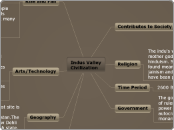Share this with a partner if you choose to share. Summarize information from our online text and add it to this graphic organizer.
Noah, Africa (Modules 22 & 23)
Global Trade (Module 23)
European Colonies
Trade in gold, ivory, and slaves made many Portuguese merchants very rich. Envious, other European countries rushed to grab part of the trade. The result was a struggle among several countries to establish colonies.
Goods Traded
Much of the intra-African trade consists of consumables—food, drinks, tobacco, sugar, cattle, and meat. The growth of industrialization in some countries, however, has been accompanied by an increase in the trade of durable and nondurable manufactured goods.
Cities
Located on the Indian Ocean, East Africa drew the attention of traders from Asia. Among these traders were Muslims from India, Persia, and Arabia. They came to Africa in search of exotic African goods and new markets for products from their homelands.
Kingdoms (Module 23)
Bantu
Bantu people are the speakers of Bantu languages, comprising several hundred indigenous ethnic groups in Africa, spread over a vast area from Central Africa, to Southeast Africa, and to Southern.
Songhai
The Songhai Empire (also transliterated as Songhay) was a state that dominated the western Sahel/Sudan in the 15th and 16th century. At its peak, it was one of the largest states in African history. The state is known by its historiographical name, derived from its leading ethnic group and ruling elite, the Songhai.
Mali
The Empire of Mali was one of the largest empires in West African History, and at its height, it spanned from the Atlantic Coast to central parts of the Sahara desert [i]. The Empire was founded in 1235 CE by the legendary King Sundiata [ii] and lasted until the early 1600s CE [iii]
Ghana
Ghana, first of the great medieval trading empires of western Africa (fl. 7th–13th century). It was situated between the Sahara and the headwaters of the Sénégal and Niger rivers, in an area that now comprises southeastern Mauritania and part of Mali.
Ethopia
In time, the descendants of the people of Oakum formed a new kingdom called Ethiopia. By about 1150 Ethiopia had become a powerful trading state.
Aksum
One of the new kingdoms that developed was Oakum (AH-sum), located near the Red Sea in northeast Africa.
Egyptians
The history of ancient Egypt is divided into three main periods: the Old Kingdom (about 2,700-2,200 B.C.E.), the Middle Kingdom (2,050-1,800 B.C.E.), and the New Kingdom (about 1,550-1,100 B.C.E.). The New Kingdom was followed by a period called the Late New Kingdom, which lasted to about 343 B.C.E.
Adaptation to Environments (Module 23)
Cultures
A Savanna Culture (Maasai)
In the savanna of East Africa, the Masai people developed a very different culture from the Bambi and the San.
A Desert Culture (San)
Like the Bambuti, the San people have lived for thousands of years as hunter-gatherers. However, their home is in a very different climate.
A Forest Culture (Bambuti)
Among the African cultures that anthropologists have studied are the Bambi of Central Africa. They live deep in the tropical rain forests of the Congo Basin and depend on the forest to provide their needs.
Early Human Site Discoveries (Module 23)
Ages
Later Stone Age
Four major groups of hominids appeared in Africa between 5 million and about 200,000 years ago. Each group was more advanced than the one before it and could use better tools.
Middle Stone Age
Perhaps the most famous Stone Age site in Africa is Olduvai Gorge. This steep canyon is located on the Serengeti Plain in northern Tanzania. Anthropologists working in the gorge have discovered the fossil remains of more than 60 hominids, or early ancestors of humans.
Early Stone Age
Early Hominid Site (p. 746)
Perhaps the most famous Stone Age site in Africa is Olduvai Gorge. This steep canyon is located on the Serengeti Plain in northern Tanzania.
Culture (Module 22)
Arts & Literature
North Africa has a rich and varied tradition in the arts and literature, which Egypt shares. While traditional arts include woodcarving and weaving, Egypt also boasts a growing movie industry.
Holidays
Egypt observes two Revolution Day holidays. The one on January 25 celebrates the 2011 revolution, while the one on July 23 celebrates the 1962 revolution, when Egypt gained its independence from Britain.
Food
Grains, vegetables, fruit, and nuts are common foods in Egypt. Meals here sometimes include a dish called couscous. It is made from wheat and looks like small pellets of pasta.
Religion
About 90 percent of Egyptians are Muslims who practice the religion of Islam.
People & Language
Egyptians and Arabic.
Climate & Resources (Module 22)
oil
Resources
natural gas.
coal.
oil.
Precipitation
In Africa there is some trouble with water.
Temperature Range
Temperatures range from mild to very hot. How hot can it get? Temperatures as high as 136°F (58°C).
Physical Features
The Sahara
The name Sahara comes from the Arabic word for “desert.”
The Nile River valley is a fertile area in the midst of the desert.
The Nile
For centuries, rain far to the south caused floods along the northern Nile, leaving rich silt in surrounding fields.
It is The worlds longest River.
Region
The Sahara is big as The United States.
There names are Morocco, Algeria, Tunisia, Libya, and Egypt.
There is five regions in North Africa.









